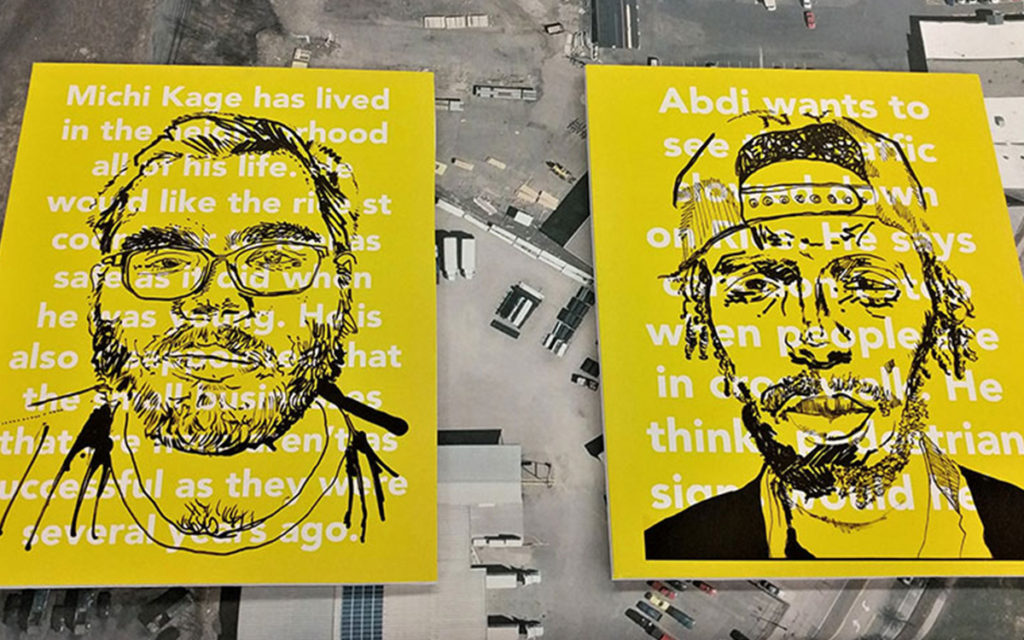Community Engagement Influences New Vision for Capitol-Rice District
Picture this. You’re at the bustling intersection of Rice Street and University Ave in Saint Paul. Beautiful four-story brick buildings with shops on the first floor and residences above speak to the vitality of this neighborhood. A streetcar whizzes by, people pop on and off, visiting the local businesses conveniently located only a block away from the State Capitol building. Sounds like a nice place to visit, go shopping, or stay a while, right?
That was the Capitol-Rice area about 100 years ago.
Fast forward to now. On the same corner you’ll find the Green Line Capitol Rice Street Station. The State Capitol still stands prominently in the background. Yet, except for the League of MN Cities building, you will find a vastly different landscape, primarily made up of surface parking lots.
The good news is that there are a group of us working to change this!

Move Minnesota’s Neighborhood Youth Team. Credit: Dang Her, ThreeSixty Journalism
Over the last several months, our community organizers and youth crew have actively been engaging the community in the Capitol-Rice district, as part of a larger planning effort to improve economic vitality along Rice Street between Pennsylvania and University Avenues, through the City of Saint Paul’s Commercial Vitality Zone (CVZ) Program. Our community engagement organizers surveyed the community looking for ground-up ideas to create a new vision for the district, with mobility as a key focus. Elevating community voices and seeking input that traditionally has been overlooked in planning processes is something we pride ourselves on. With nearly 250 surveys taken, a wide range of demographics, and a nearly even split between workers and residents, our team is making sure everyone’s voice is heard.
One interesting finding is that over 60 percent of respondents said they often biked or walked to get around, showing the growth potential for walking and biking on this corridor. Infrastructure improvements for biking and walking, and increased awareness of pedestrian and bicyclist rights were among the most commonly cited desires for the area.
Our organization is working with the Capitol Area Architectural and Planning Board (CAAPB) to inform Capitol-Rice CVZ planning, and it’s an exciting time to be involved in community engagement here.
On Monday, January 29, in the basement of Christ Lutheran Church on Capitol Hill, community members collaborated with city planners and zoners to plan for the future of the Capitol-Rice area.
That Monday–part-celebration, part-packed agenda–was a great milestone for this work. The event started off with a short series of presentations about the neighborhood, its history and trajectory, and was followed by a panel of community leaders discussing their involvement with the project. After the presentations and panel, the event was opened up into an open house with community findings on display, along with incredible performances from local artists and musicians.
Prior to the event, CAAPB compiled the results from over 500 community comments collected during the engagement process and found that these were the top five emerging themes:
- Rice Street Re-Design: New street design and greening guidelines for rain gardens and street tree planting
- Anti-Displacement: Implement strategies to help the community prepare for new developments and public realm investments while minimizing potential negative effects
- Support Entrepreneurs and Small Business Development: Opportunity sites for smaller scale redevelopment
- Como Connectivity: Implement an outdoor market along Como Avenue
- Leif Erickson Park as Landmark Urban Space with Integrated Mobility Hub
The seventy community members in attendance were encouraged to read all about the community-based plans and ideas that had surged as a result, and were able to vote on the plans and ideas that most resonated with them.
We’re very excited about this work, as it has the potential to directly impact the district through policy and programmatic changes to residential and business uses, green spaces, public art, and improved transit/pedestrian infrastructure.
Transportation is only one piece of making the area prosperous and returning to the vision from 100 years ago, but it is also integral to access and employment for many residents. Carefully considering community input is how we are helping make future investments in the area–and throughout Saint Paul–the best they can be.
Featured image: Community feedback on neighborhood planning, turned into visual art. Artist Credit: Witt Siasoco

